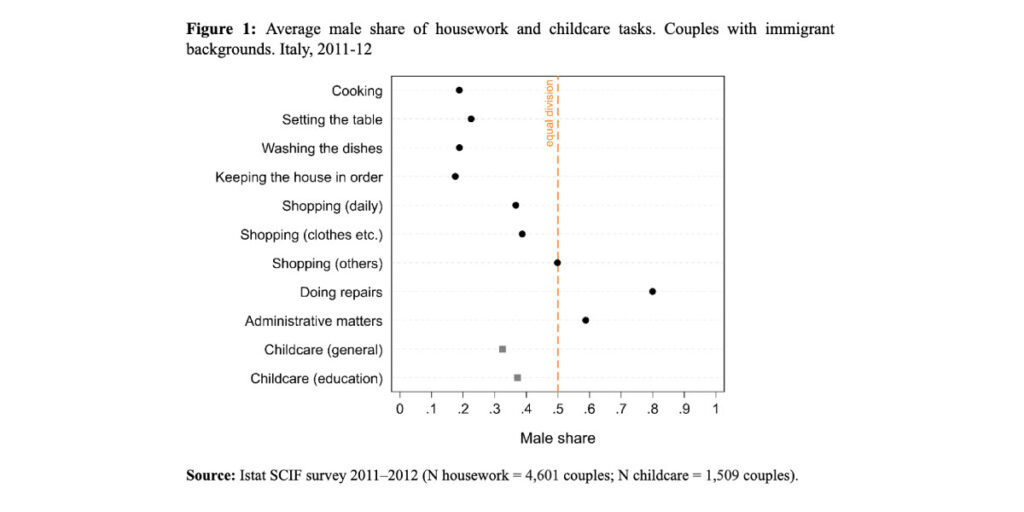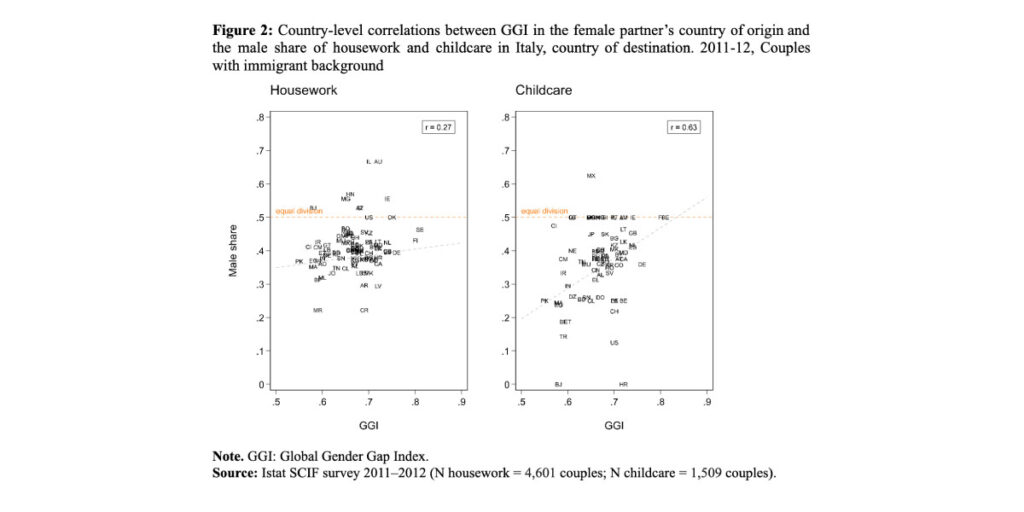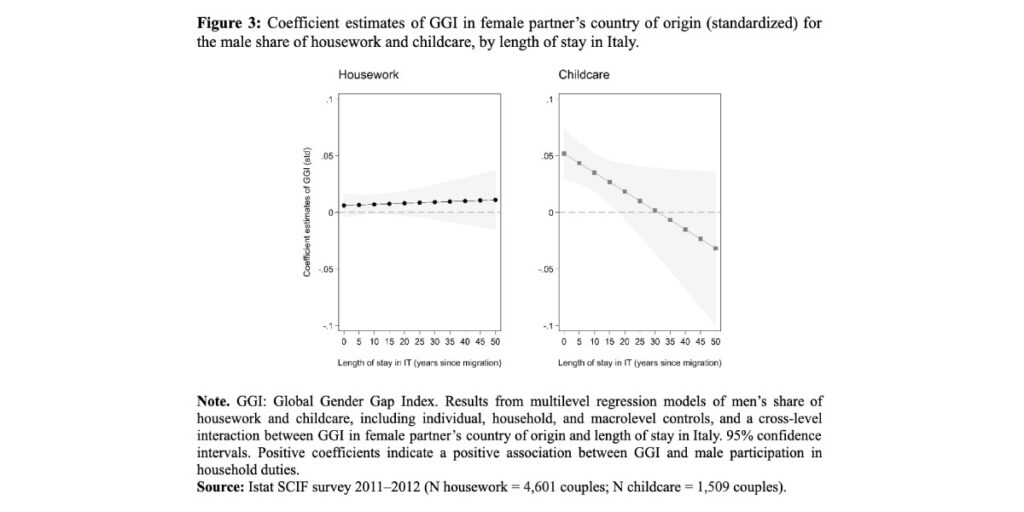Gender inequality in the division of housework persists. Elisa Brini, Anna Zamberlan and Paolo Barbieri investigate if cultural heritage is resistant to changes in socioeconomic and institutional environment by studying migrant families. Cultural roots are a factor of gender inequality in housework and childcare, but they fade over time in destination countries.
Women in the kitchen, men in the yard
Women today are more highly educated than men and increasingly present in the labour market; yet they continue to perform most of the household labour (Zamberlan, Gioachin, and Gritti 2021, 2022). Analysing Italian data from the Social Condition and Integration of Foreigners (SCIF) survey (ISTAT 2011–2012), this holds true for immigrant couples as well. Figure 1 shows the extent to which couples with an immigrant background and residing in Italy divide different domestic and childcare duties. The overwhelming majority of tasks such as preparing meals, laying the table, doing the dishes, keeping the house clean, or caring for children, are performed by women. Men do more than women only when it comes to typically male activities, such as doing repairs and dealing with administrative matters.

Looking for an explanation
Why is there still a gender gap in domestic work? While the time available to partners and individual resources such as education and income are key determinants of the unequal division of unpaid work, the relevance of cultural aspects is still a matter of debate. Traditional gender roles, inherited from the family or from the wider context of origin, could have a bearing on the behaviour of men and women by crystallizing gender inequality even within the home. The study of immigrant families in Italy offers an opportunity to tease out the role of cultural aspects. Upon moving to the same host country, immigrants share a common institutional and cultural environment while having different cultural heritages from their origin countries and different perceptions of gender equity. If the culture of origin matters, domestic and childcare tasks should be more (less) equally shared among couples coming from more (less) gender-egalitarian countries.
Culture matters
The World Bank’s Global Gender Gap Index (GGI) provides a useful indicator for measuring and comparing gender equality across countries. A value of 1 indicates a country with the highest possible score of gender equality, while a value of 0 indicates a country with the lowest possible score. Figure 2 shows the correlation between the GGI score of the female partner’s origin country and the share of male participation in household chores and childcare in the host country. Men assume a larger share of housework and, even more so, of childcare in couples where the woman comes from a more egalitarian country. Arriving from a context with a more egalitarian gender culture goes along with a more equitable division of household duties in the destination country.

A fading heritage?
The families under investigation have different migration histories. As more time is spent in Italy, the gender culture inherited from the context of origin could lose relevance as a result of prolonged contact with a different institutional and cultural context. Figure 3 confirms this expectation, but only with regard to childcare activities. Indeed, the relationship between GGI and male participation in housework is positive but close to 0 and independent of the number of years spent in Italy. Conversely, the association between GGI and fathers’ involvement in childcare is positive at the beginning, but it gradually diminishes as time spent in the destination country (Italy) increases.

Conclusions
Studying how immigrant families divide housework and childcare tasks is informative for understanding the cultural component of gender inequality. While it is true that the culture of origin influences the behaviour of partners even in a different socioeconomic context, there are substantial differences based on the type of activity and the time spent in the host country. Cultural heritage is mainly relevant for explaining gender differences in childcare activities, while the role of culture is marginal with regard to other domestic tasks. In addition, the influence of culture weakens considerably, and eventually disappears as time spent in the destination country increases. The disappearance of cultural effects may suggest the presence of a cultural assimilation mechanism, although in the absence of longitudinal data, this can only be inferred.
References
Brini, E., Zamberlan, A. and Barbieri, P. (2022). Culture portability from origin to destination country: The gender division of domestic work among migrants in Italy. Demographic Research, (47)20, 577–614
Zamberlan, A., Gioachin, F., and Gritti, D. (2021). Work less, help out more? The persistence of gender inequality in housework and childcare during UK COVID- 19. Research in Social Stratification and Mobility 73: 100583. Zamberlan, A., Gioachin, F., and Gritti, D. (2022). Gender inequality in domestic chores over ten months of the UK COVID-19 pandemic: Heterogeneous adjustments to partners’ changes in working hours. Demographic Research 46(19): 565–580.


